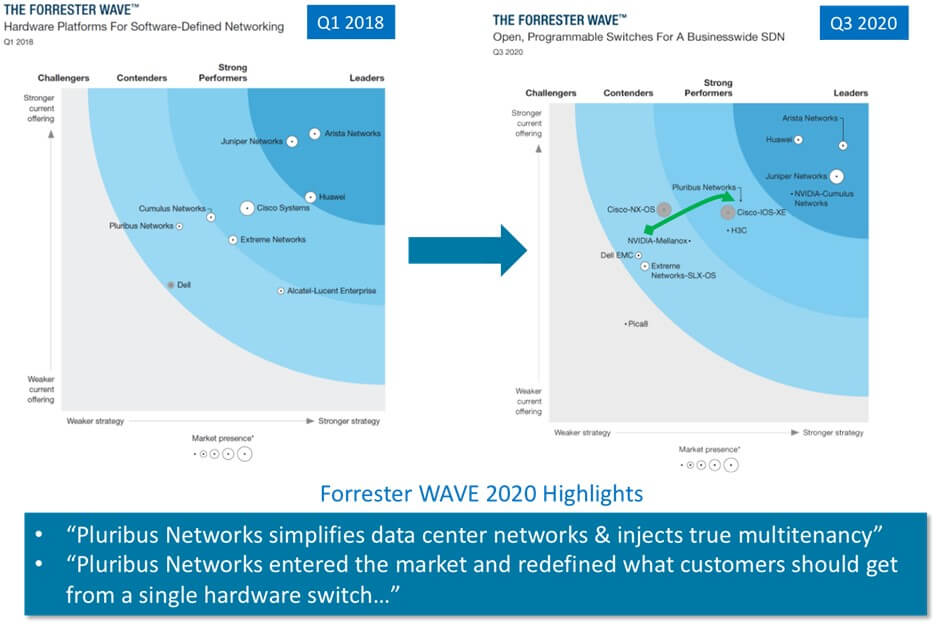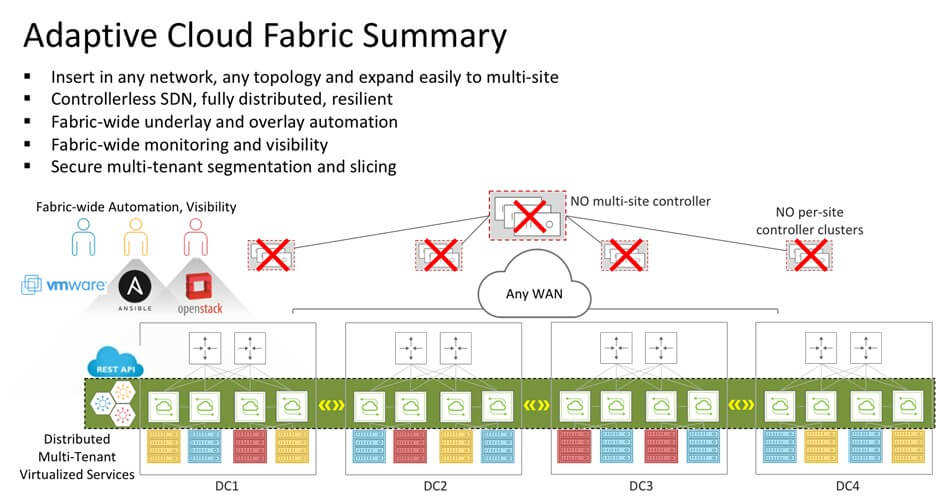On September 3rd I had the pleasure of hosting a webinar with one of our key open networking software partners Pluribus Networks Automating Distributed Data Centers with Controllerless SDN and Open Networking. In the webinar I started out educating the audience on the basics of a networking fabric and the value of overlay networking – the ability to run a homogenous virtual network providing Layer 2 and Layer 3 services running on top of VXLAN tunnels which in turn run over any Layer 3 underlay. Deploying overlay fabrics is a best practice in data center networking as it increases agility and allows services to be deployed at the speed of cloud. I was joined by Mike Capuano from Pluribus Networks who then covered the various approaches in the industry to implement the overlay portion of the fabric along with associated pros and cons. Mike then went into detail on the Pluribus SDN control plane and just how simple it is to deploy and operate an overlay network fabric. Since we have been doing a lot more business with Pluribus I have really gotten to see the Pluribus progress over these last 2 years.
In fact, I was pleased to see what large jump Pluribus made in the latest Forrester Wave for Open, Programmable Switches for a Business Wide Software Defined Network (SDN) Q3 2020. I can attest that Pluribus’ Linux-based Netvisor ONE® operating system and Adaptive Cloud Fabric™ (ACF) solution have really matured into an extremely powerful data center offering. In fct Pluribus has been deployed in over 300 customers including cloud service providers, SaaS providers, all sizes of enterprise/government/education and into the mission-critical virtualized cores of 75 Tier 1 mobile operators. Another key achievement to note in this report that the Pluribus offering surpassed Cisco both in terms of Current Offering and Strategy and they have matched Cumulus Networks/Nvidia on Current Offering (the vertical Y axis in the chart).

Just this past week Pluribus put an exclamation point on their progress as they announced some key architectural innovations which will enable ACF to scale to the largest fabric available in the industry. You can read more in their blog Thousand-node Fabrics: Scaling and Extending the Adaptive Cloud Fabric with Controllerless SDN and EVPN. Pluribus also introduced what they call EVPN Open Fabric Extension. This allows Pluribus to be deployed in a multi-vendor environment where the Adaptive Cloud Fabric with its SDN control plane will run BGP EVPN on the border gateway nodes that will interoperate with other BGP EVPN based fabrics.
I have to admit, when I first started working with Pluribus, I was surprised that the Adaptive Cloud Fabric was based on an SDN control plane and not a BGP EVPN control plane. But the more I have worked with this solution the more I have come to understand the power of this approach. Inside the overlay fabric, that is typically deployed as a mesh of VXLAN tunnels directly connecting every leaf switch to every other leaf switch, is a controllerless SDN control plane and thus the interior of overlay fabric is protocol free. What do I mean by controllerless? The SDN control plane is very efficiently written code that uses the resources of the distributed switches themselves to run the SDN control – Intel multi-core CPU, RAM, SSD – instead of the typical 3 external controllers required at every site.

This allows numerous benefits, too many to go into in this blog but reach out to me if you are interested in a more detailed briefing. Pluribus also uses SDN to automate the underlay, but the underlay uses standard protocols like BGP or OSPF for the control plane, SDN just automates the consistent configuration of each switch. However, the overlay is protocol free and leverages a compact vPort database which allows every switch to hold the state of the entire fabric. What are the benefits of this approach?
- Ease of Use: using the example of a 256-switch fabric, it takes 5,000 commands with BGP EVPN configured on every leaf switch to deploy a VRF fabric-wide. Yes that is for one service only. Of course there can be some level of automation with Ansible but this is still a huge amount of work. With the Adaptive Cloud Fabric it takes only 3 commands issued via CLI or the REST API with the “Fabric Scope” attribute to deploy the same VRF fabric-wide. Of course, Pluribus also supports Ansible but with only 3 commands to issue it may not be needed in many cases. Even when Pluribus deploys EVPN for interop with other EVPN fabrics, it is configured only on 2 border gateway nodes. So in a 32 switch fabric EVPN needs to be configured on 32 switches for the protocol based fabric but only 2 switches for SDN-based ACF.
- Configuration integrity: The Pluribus solution ensures that when a fabric scope command is issued that every switch in the fabric can commit the config. If one switch cannot accept the config then it is rolled back on every switch to the last config until that issue is addressed. This reduces human error and ensures consistent configs and security policies are applied across the fabric.
- Service Scale: looking at one of Pluribus’ key competitors, Cumulus Networks supports only 256 VRFs in a fabric using BGP EVPN. This is because the heavy BGP EVPN protocol taxes white box resources. Pluribus, on the other hand, supports 4,000 VRFs, limited only by the Broadcom Trident 3 switch chip. As fabrics become larger and multi-tenant in nature more VRFs and network services will be required.
Speaking of Cumulus, if you are looking for an alternative for your data center fabric I think the Pluribus offering is a worth a hard look. In fact Pluribus has some special pricing incentives for customers looking at moving away from Cumulus and they have a nice write up on this very topic here.
Finally, it is important to note that Pluribus addresses use cases beyond the single site data center fabric.
- Multi-site data center / edge compute - The Pluribus Adaptive Cloud Fabric simplifies multi-site data center networking, seamlessly interconnecting geographically distributed locations into a unified network fabric. With a controllerless SDN architecture incorporating network virtualization for secure multi-tenant segmentation, as well as built-in monitoring and analytics for pervasive network visibility, Pluribus delivers the best multi-site data center fabric.
- Packet Broker - The NPB solution can be deployed in-line to create a dynamic security fabric for traffic segmentation and service insertion, or out-of-band for high-scale, highly flexible traffic aggregation, filtering, replication and advanced packet processing. And because Pluribus NPB solutions are built on a foundation of the Pluribus Adaptive Cloud Fabric and open networking Ethernet switches, they are inherently highly automated, resilient and cost-effective.
- IOT Video Surveillance Transport - Traditional IP networking approaches require a costly router implementing Protocol Independent Multicast (PIM) to be deployed and configured at every hop in the network and consume scarce IT resources for complex provisioning, monitoring and troubleshooting of hundreds or thousands of multicast video streams. ACF simplifies distributed multi-site IoT video networking with fabric-wide automation and an innovative distributed multicast forwarding architecture dramatically simplify IoT video networks.
- Metro Cloud Services – In release 6.0 Pluribus introduced E-Tree service in the overlay leveraging bridge domains, with use cases Metro Ethernet access/aggregation and complementing existing E-Line and E-LAN services to round out a full portfolio of Carrier Ethernet 2.0 services.
As always, I would be more than happy to share additional resources with you. For more technical information on Pluribus Networks or Open Networking give me a shout. You can also browse our Open Networking products here.
Slán go fóill,
Barry